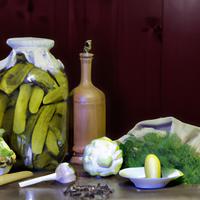
1 serving (30 grams) contains 4 calories, 0.2 grams of protein, 0.1 grams of fat, and 0.8 grams of carbohydrates.

Log this food in SnapCalorie

Nutrition Information
Calories |
32.0 | ||
|---|---|---|---|
% Daily Value* |
|||
| Total Fat | 0.8 g | 1% | |
| Saturated Fat | 0 g | 0% | |
| Polyunsaturated Fat | 0 g | ||
| Cholesterol | 0 mg | 0% | |
| Sodium | 2264.0 mg | 98% | |
| Total Carbohydrates | 6.4 g | 2% | |
| Dietary Fiber | 2.4 g | 8% | |
| Sugars | 3.2 g | ||
| protein | 1.6 g | 3% | |
| Vitamin D | 0 mcg | 0% | |
| Calcium | 48 mg | 3% | |
| Iron | 0.8 mg | 4% | |
| Potassium | 280.0 mg | 5% | |
* Percent Daily Values are based on a 2,000 calorie diet. Your daily values may be higher or lower depending on your calorie needs.
Food Attributes
Source of Calories
About Homemade pickles
Homemade pickles are a tangy, flavorful staple of many cuisines, originating from ancient preservation methods used across cultures, including Eastern European, Indian, and American traditions. Typically made by fermenting or brining fresh vegetables—most commonly cucumbers—with a mixture of water, vinegar, salt, and spices, these pickles boast a bold taste and satisfying crunch. Nutritionally, homemade pickles can be a low-calorie snack and a source of probiotics if naturally fermented, which contribute to gut health and digestion. However, their high sodium content from the brining process can be a concern for individuals monitoring their salt intake. Versatile and delicious, homemade pickles can be enjoyed on their own, in sandwiches, or as a side dish, adding zest to any meal while spotlighting the health benefits of preserved vegetables in moderation.



